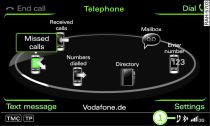-

- Fig. 1 Telephone settings
-

- Fig. 2 Media settings
-

- Fig. 3 Selecting a telephone number from a list
After pressing a function selector button
Link ,
the corresponding menu will appear on the MMI display.
(A)
(B) Symbol / marking
(C) Explanation
(B) Symbol / marking
(C) Explanation
| (A) |
(B) |
(C) |
|---|---|---|
| -1- |
Heading |
Indicates the selected mode (e.g.
Radio). |
| -2- |
Selected option |
A selected item
is framed. |
| -3- |
Arrows pointing up/down |
Indicate further
menu options (next/previous page). |
| -4- |
TMC/TMCpro symbol |
Reception of
TMC/TMCpro traffic messages
|
| -5- |
Telephone status display* |
Indicates import/update
of contacts in the directory/call lists. |
| -6- |
Envelope* |
Indicates that
there is an unread text message
Link. Crossed-out envelope: text message memory is full Link. |
| -7- |
Bluetooth symbol |
Active Bluetooth
connection. |
| -8- |
Signal strength indicator* |
Reception strength
of mobile phone network, or PIN: Entering SIM PIN Link. PUK: Entering PUK Link. SIM: Inserting SIM card |
| -9- |
Arrow |
Indicates more
selection or setting possibilities. |
| -10- |
Selection box |
Selection possibilities
for selected item. |
| -11- |
Path/subheading |
Indicates the
path to the selected function/informs about the selected function. |
| -12- |
Mute symbol |
The current audio/video
source is muted. |
| -13- |
TP symbol |
Reception of
traffic reports
Link. |
| -14- |
Display of copying process
status |
Audio/video files
are being copied to the jukebox
Link. |
| -15- |
Telephone symbol* |
Missed calls
Fig. 3. |
| -16- |
2G/3G* |
Network coverage
Link 2G: GSM network 3G: UMTS network |
